Dengfeng
登封市 Tengfeng | |
|---|---|
 The Daoist Zhongyue Temple | |
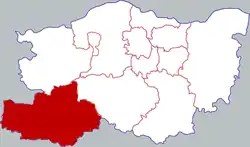 Location in Zhengzhou | |
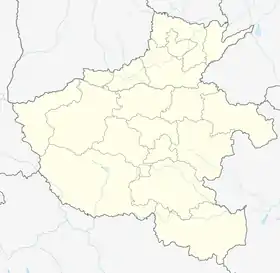 Dengfeng Location in Henan | |
| Coordinates: 34°27′19″N 113°1′31″E / 34.45528°N 113.02528°E | |
| Country | People's Republic of China |
| Province | Henan |
| Prefecture-level city | Zhengzhou |
| Area | |
| • Total | 1,220 km2 (470 sq mi) |
| Population (2019)[1] | |
| • Total | 717,400 |
| • Density | 590/km2 (1,500/sq mi) |
| Time zone | UTC+8 (China Standard) |
| Postal code | 452470 |
| Website | www |
| Official name | Historic Monuments of Dengfeng in "The Center of Heaven and Earth" |
| Includes |
|
| Criteria | Cultural: (iii)(vi) |
| Reference | 1305rev |
| Inscription | 2010 (34th Session) |
| Area | 825 ha (2,040 acres) |
| Buffer zone | 3,438.1 ha (8,496 acres) |
Dengfeng (Chinese: 登封; pinyin: Dēngfēng; postal: Tengfeng) is a county-level city of Henan Province, China. It is under the administration of the prefecture-level city of Zhengzhou. In ancient times, it was known as Yangcheng (traditional Chinese: 陽城; simplified Chinese: 阳城; pinyin: Yángchéng).
Dengfeng has an area of 1,220 km2 (470 sq mi) and a population of 630,000.[2] It occupies the southwestern corner of Zhengzhou and is its westernmost county-level division.
Dengfeng is located at the foot of the Mount Song, one of the most sacred mountains in China. The city is one of the most renowned spiritual centers of China, and is home to various religious institutions and famous temples such as the Taoist Zhongyue Temple, the Buddhist Shaolin Temple (a renowned center for martial arts), as well as the Confucian Songyang Academy and the Gaocheng Observatory, hence its poetic expression derived from Chinese literature as the spiritual "center of heaven and earth".[3] Parts of the city were inscribed on the UNESCO World Heritage List in 2010.[3]
History
The first Xia Dynasty capital, Yangcheng, was built west of Gaocheng Township on the Yin River under the sacred Mount Song.
The famous Shaolin Monastery, traditionally considered the origin of Zen, is located in Dengfeng where they teach adults as well as children martial arts. It is also a famous tourist attraction.
Administrative divisions
As of 2012, the city is divided to 3 subdistricts, 8 towns and 5 townships.[4]
- Subdistricts
|
|
- Towns
|
|
- Townships
|
|
UNESCO World Heritage Site

In 2010, UNESCO inscribed several of the most renowned sites of Dengfeng onto its World Heritage List under the title "Historic Monuments of Dengfeng in 'The Center of Heaven and Earth'."[5] The World Heritage Site includes several historic gates, temples, a Confucian academy and the Gaocheng Observatory:[6]
- Taishi Que (太室闕) Gates: Gates built in front of what would become the Zhongyue Temple in 118 AD, with carved reliefs of animals, trees, and spirits.[7]
- Zhongyue Temple: A Taoist temple constructed in the 5th century, during Kou Qianzhi's reforms. Includes Juni Hall, a large hall for sacrificing to the gods, two stone statues built in 118 AD that are the oldest surviving stone statues in China.[7]
- Shaoshi Que Gates: Han Dynasty gates (dating to 123 AD), with pictures of horses galloping, a circus, and cuju, and ancient football game.[7]
- Qimu Que Gates: A pair of gates built in 123 AD, with images that depict scenes of cockfights, floods, and visitation by the Roman Empire[7]
- Songyue Temple Pagoda: Built between 508 and 511, it had very innovative architecture and became a template for many future pagodas.[7]
- Shaolin Monastery and its Pagoda Forest: A complex of temples and over 240 pagodas, built over 1300 years starting in the 5th century. A major sacred site for Buddhism.[7]
- Huishan Temple: A wooden temple built in the 12th century on the site of the astronomer Yi Xing's residence.[7]
- Songyang Academy: Created in the Tang Dynasty, it was considered one of the four greatest academies of classical learning in China. Contributed to the dissemination of Confucianism across China.[7]
- Gaocheng Astronomical Observatory: an observatory built in the 13th century to accurately measure the world and create precise calendars.[3]
Other notable sites in Dengfeng include the Fawang Temple, a Buddhist temple built in the Tang Dynasty.
Climate
| Climate data for Dengfeng (1991–2020 normals, extremes 1981–2010) | |||||||||||||
|---|---|---|---|---|---|---|---|---|---|---|---|---|---|
| Month | Jan | Feb | Mar | Apr | May | Jun | Jul | Aug | Sep | Oct | Nov | Dec | Year |
| Record high °C (°F) | 18.8 (65.8) |
21.8 (71.2) |
31.7 (89.1) |
38.5 (101.3) |
38.0 (100.4) |
40.1 (104.2) |
39.4 (102.9) |
37.0 (98.6) |
37.6 (99.7) |
31.2 (88.2) |
27.4 (81.3) |
21.4 (70.5) |
40.1 (104.2) |
| Mean daily maximum °C (°F) | 5.6 (42.1) |
9.1 (48.4) |
14.8 (58.6) |
21.7 (71.1) |
26.8 (80.2) |
30.7 (87.3) |
31.1 (88.0) |
29.7 (85.5) |
25.7 (78.3) |
20.6 (69.1) |
13.7 (56.7) |
7.7 (45.9) |
19.8 (67.6) |
| Daily mean °C (°F) | 1.1 (34.0) |
4.1 (39.4) |
9.5 (49.1) |
16.1 (61.0) |
21.5 (70.7) |
25.6 (78.1) |
26.6 (79.9) |
25.3 (77.5) |
21.1 (70.0) |
15.8 (60.4) |
9.0 (48.2) |
3.2 (37.8) |
14.9 (58.8) |
| Mean daily minimum °C (°F) | −2.5 (27.5) |
0.2 (32.4) |
5.0 (41.0) |
10.9 (51.6) |
16.3 (61.3) |
20.6 (69.1) |
22.8 (73.0) |
21.6 (70.9) |
17.1 (62.8) |
11.7 (53.1) |
5.2 (41.4) |
−0.3 (31.5) |
10.7 (51.3) |
| Record low °C (°F) | −9.9 (14.2) |
−10.1 (13.8) |
−5.4 (22.3) |
−0.2 (31.6) |
7.2 (45.0) |
12.8 (55.0) |
17.4 (63.3) |
11.3 (52.3) |
9.8 (49.6) |
0.6 (33.1) |
−4.3 (24.3) |
−9.3 (15.3) |
−10.1 (13.8) |
| Average precipitation mm (inches) | 9.5 (0.37) |
11.5 (0.45) |
19.8 (0.78) |
35.9 (1.41) |
57.2 (2.25) |
65.6 (2.58) |
133.1 (5.24) |
102.1 (4.02) |
69.6 (2.74) |
38.5 (1.52) |
24.8 (0.98) |
7.4 (0.29) |
575 (22.63) |
| Average precipitation days (≥ 0.1 mm) | 4.1 | 4.2 | 5.7 | 6.1 | 7.5 | 8.2 | 11.8 | 11.0 | 9.0 | 6.8 | 5.3 | 3.6 | 83.3 |
| Average snowy days | 5.0 | 4.1 | 2.2 | 0.3 | 0 | 0 | 0 | 0 | 0 | 0 | 1.5 | 3.6 | 16.7 |
| Average relative humidity (%) | 50 | 53 | 52 | 53 | 54 | 58 | 72 | 74 | 67 | 59 | 56 | 49 | 58 |
| Mean monthly sunshine hours | 140.0 | 143.5 | 178.8 | 207.2 | 219.6 | 207.1 | 181.7 | 177.9 | 159.4 | 166.0 | 151.0 | 151.5 | 2,083.7 |
| Percent possible sunshine | 45 | 46 | 48 | 53 | 51 | 48 | 42 | 43 | 43 | 48 | 49 | 50 | 47 |
| Source: China Meteorological Administration[8][9] | |||||||||||||
Transportation
Gallery
 Mt. Shaoshi
Mt. Shaoshi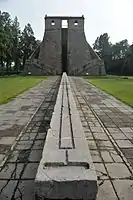 Gaocheng Observatory
Gaocheng Observatory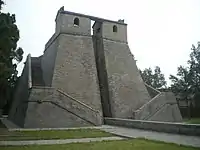 Dengfeng Observatory
Dengfeng Observatory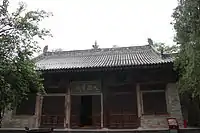 Huishan Temple
Huishan Temple.jpg.webp) Shaolin Temple
Shaolin Temple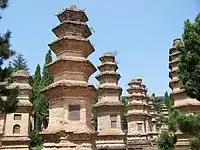 Pagoda Forest, Shaolin temple
Pagoda Forest, Shaolin temple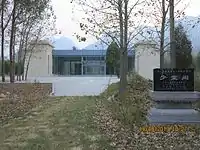 Shaoshi Que
Shaoshi Que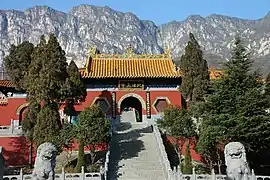 Fawang Temple
Fawang Temple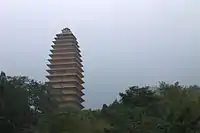 Fawang temple Pagoda
Fawang temple Pagoda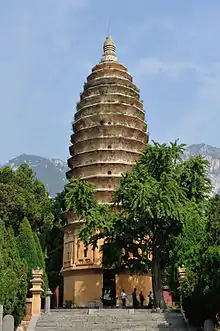 Pagoda of Songyue temple
Pagoda of Songyue temple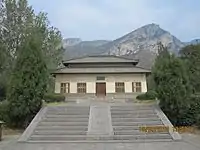 Taishi Que
Taishi Que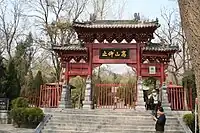 Songyang Academy
Songyang Academy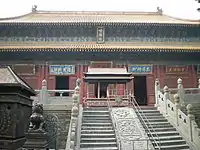 Zhongyue Temple
Zhongyue Temple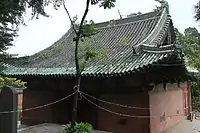 Chuzu Temple
Chuzu Temple Monk Statue at Shaolin Temple
Monk Statue at Shaolin Temple
See also
References
- 1 2 最新人口信息 www.hongheiku.com (in Chinese). hongheiku. Retrieved 2021-01-12.
- ↑ (in Chinese) Introduction to Dengfeng Archived 2007-10-22 at the Wayback Machine, official website of Dengfeng Government, visited on April 12, 2008.
- 1 2 3 "Historic Monuments of Dengfeng in "The Center of Heaven and Earth"". UNESCO World Heritage Center.
- ↑ 洛阳市-行政区划网 www.xzqh.org (in Chinese). XZQH. Retrieved 2012-05-24.
- ↑ Historic Monuments of Dengfeng in "The Center of Heaven and Earth." UNESCO World Heritage Center
- ↑ Historic Monuments of Dengfeng in "The Center of Heaven and Earth." UNESCO World Heritage Center
- 1 2 3 4 5 6 7 8 Historic Monuments of Dengfeng (China)L ICOMOS Evaluation (Report). International Council on Monuments and Sites. Retrieved 17 Apr 2021.
- ↑ 中国气象数据网 – WeatherBk Data (in Simplified Chinese). China Meteorological Administration. Retrieved 12 August 2023.
- ↑ 中国气象数据网 (in Simplified Chinese). China Meteorological Administration. Retrieved 12 August 2023.


